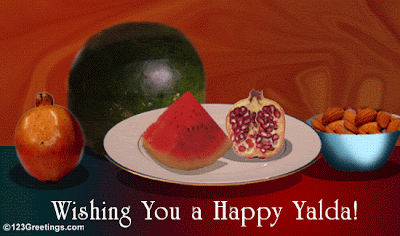 Most everyone who has had any exposure to Iranian, Kurdish, Turkish, and Central Asian cultures or to adherents of the Zoroastrian and Baha'i faiths knows about Nowruz/New Year's/the Spring Equinox in March. Those outside the Irano-Persian cultural sphere may be less familiar with the Winter Solstice festival. As I noted last year,
Most everyone who has had any exposure to Iranian, Kurdish, Turkish, and Central Asian cultures or to adherents of the Zoroastrian and Baha'i faiths knows about Nowruz/New Year's/the Spring Equinox in March. Those outside the Irano-Persian cultural sphere may be less familiar with the Winter Solstice festival. As I noted last year,For Iranan readers, the Iranian Diaspora and those from countries whose cultural traditions derive from Iran (in Central Asia and the Caucasus), greetings for Yalda, or Shab-e Yalda (شب یلدا, Yalda Night) the ancient Iranian celebration of the Winter Solstice. Originally marking the Birth of Mithra (that is, the annual "rebirth" of the sun at the solstice), it survives, like Nowruz in the spring, as a seasonal celebration of winter, marked by pomegranates, watermelon, and other traditional foods.I ended last year's post with "Take that, Mayans." (Some of you may have already forgotten that the Mayan Calendar, and the world with it, ended a year ago, although personally I hardly noticed.)
Saturday is the solstice, so Yalda greetings to those who mark it.
The Wikipedia article offers the following:
Yalda (Persian: یلدا), Shab-e Yalda (Persian: شب یلدا), "Night of Birth", or Zayeshmehr (Persian: زایش مهر) "Birth of Mithra", or Shab-e Chelleh (Persian: شب چلّه, Azerbaijani: چیلله گئجهسی; lit. "Night of Forty") is the Persian winter solstice celebration which has been popular since ancient times. Yalda is celebrated on the Northern Hemisphere's longest night of the year, that is, on the eve of the Winter Solstice. Depending on the shift of the calendar, Yalda is celebrated on or around December 20 or 21 each year.
Yalda has a history as long as the religion of Mithraism. The Mithraists believed that this night is the night of the birth of Mithra, Persian angel of light and truth. At the morning of the longest night of the year the Mithra was born.
Following the fall of the Sassanid Empire and the subsequent rise of Islam in Persia/Iran, the religious significance of the event was lost, and like other Zoroastrian festivals, Yalda became a social occasion when family and close friends would get together. Nonetheless, the obligatory serving of fresh fruit during mid-winter is reminiscent of the ancient customs of invoking the divinities to request protection of the winter crop.I think that may be a little confused since Zoroastrianism is much older than Mithraism, and the feast relates to both faiths.
The traditional fruits:
The traditional watermelon:
The Mithra imagery:








No comments:
Post a Comment